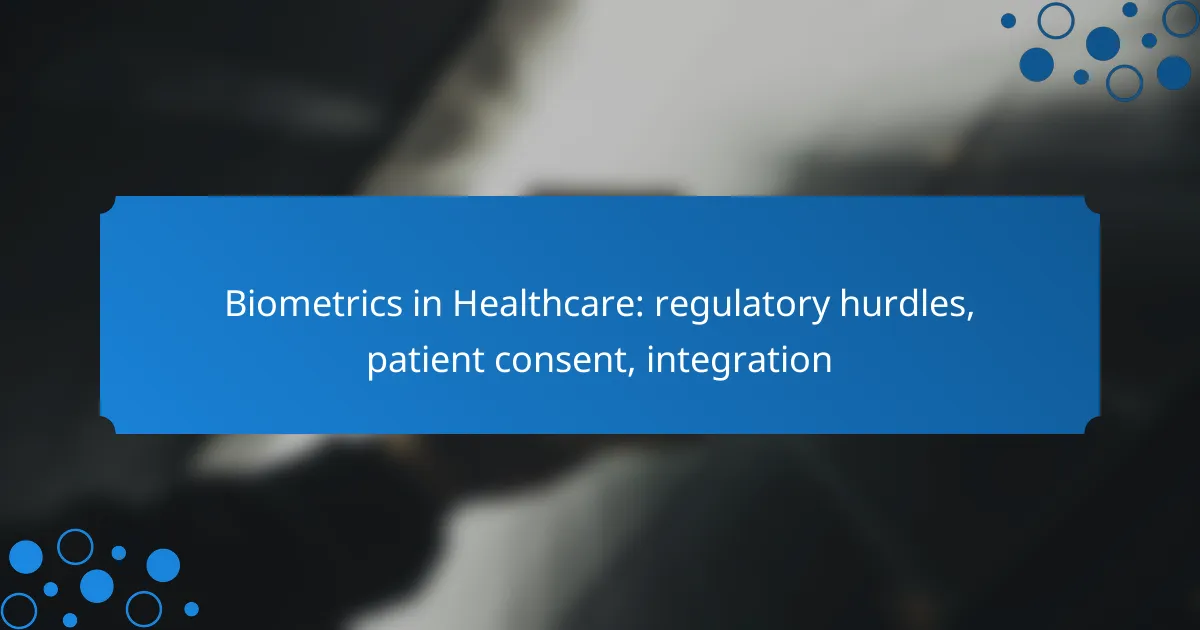Biometrics in healthcare offers innovative solutions for patient identification and data security, but it faces significant regulatory hurdles, particularly concerning privacy laws and patient consent. Ensuring compliance with these regulations is crucial for the ethical collection and use of biometric data. Additionally, the integration of biometric systems into healthcare settings poses challenges related to interoperability, data security, and associated costs, which can affect their overall effectiveness.

What are the regulatory hurdles for biometrics in healthcare in Canada?
In Canada, regulatory hurdles for biometrics in healthcare primarily involve compliance with privacy laws and guidelines that protect personal information. These regulations ensure that biometric data is collected, stored, and used in a manner that respects patient consent and confidentiality.
Compliance with Personal Information Protection and Electronic Documents Act (PIPEDA)
PIPEDA governs how private sector organizations collect, use, and disclose personal information in the course of commercial activities. For healthcare providers using biometric data, compliance means obtaining explicit consent from patients before collecting their biometric identifiers, such as fingerprints or facial recognition data.
Organizations must also implement robust security measures to protect biometric data from unauthorized access and breaches. Failure to comply with PIPEDA can result in significant penalties and damage to patient trust.
Health Canada guidelines on biometric data
Health Canada provides specific guidelines for the use of biometric data in healthcare settings, emphasizing the importance of patient safety and privacy. These guidelines outline best practices for the secure collection and management of biometric information, ensuring that it is used only for legitimate healthcare purposes.
Healthcare organizations must regularly review their biometric systems to ensure they align with Health Canada’s recommendations, which may include conducting risk assessments and implementing data encryption technologies.
Provincial regulations affecting biometric usage
In addition to federal regulations, each province in Canada may have its own laws regarding the use of biometric data in healthcare. For instance, some provinces have enacted specific legislation that addresses the collection and use of biometric identifiers, which can vary significantly.
Healthcare providers must stay informed about these provincial regulations to ensure compliance and avoid potential legal challenges. Regular training and updates for staff on local laws can help mitigate risks associated with biometric data usage.
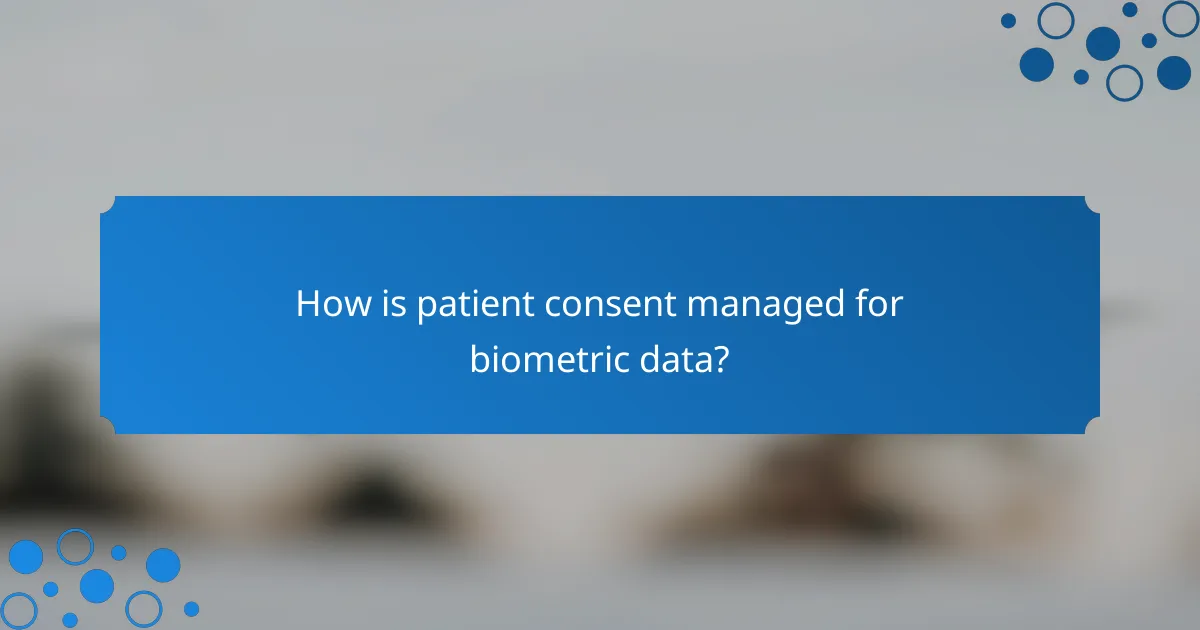
How is patient consent managed for biometric data?
Patient consent for biometric data is managed through a structured process that ensures individuals are fully informed about how their data will be used. This involves obtaining explicit permission from patients before collecting or processing their biometric information, adhering to legal and ethical standards.
Informed consent requirements
Informed consent requires that patients understand the purpose, risks, and benefits of providing their biometric data. Healthcare providers must clearly communicate how the data will be used, stored, and shared, ensuring that patients have the opportunity to ask questions. Regulations like the Health Insurance Portability and Accountability Act (HIPAA) in the United States outline specific requirements for obtaining consent.
Additionally, consent forms should be written in clear, accessible language, avoiding technical jargon that could confuse patients. This transparency is crucial for building trust and ensuring compliance with legal standards.
Best practices for obtaining consent
Best practices for obtaining consent include using a multi-step process that allows patients to engage with the information. Start with an initial discussion about biometric data, followed by providing written materials that detail the consent process. This can help patients make informed decisions.
Healthcare providers should also consider using digital platforms for consent management, which can streamline the process and enhance patient understanding through interactive elements. Regular training for staff on consent procedures can further improve compliance and patient experience.
Patient rights regarding biometric data
Patients have specific rights regarding their biometric data, including the right to access, correct, and delete their information. They should be informed about how to exercise these rights and the implications of their decisions. For instance, patients can request to withdraw consent at any time, which must be honored by the healthcare provider.
Moreover, patients should be made aware of their rights under local regulations, such as the General Data Protection Regulation (GDPR) in Europe, which provides robust protections for personal data, including biometric information. Understanding these rights empowers patients and fosters a more ethical approach to data management in healthcare.
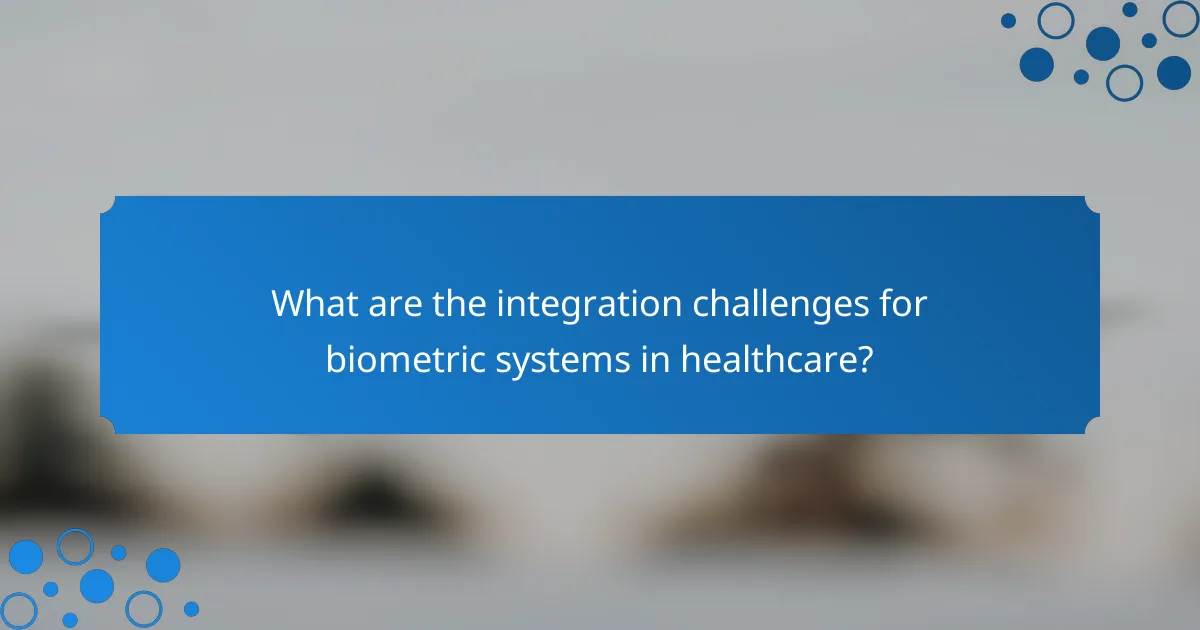
What are the integration challenges for biometric systems in healthcare?
Integrating biometric systems into healthcare presents several challenges, primarily related to interoperability, data security, and cost. These factors can significantly impact the successful deployment and functionality of biometric technologies in clinical settings.
Interoperability with existing health IT systems
Interoperability refers to the ability of different health IT systems to communicate and exchange data effectively. For biometric systems to function seamlessly, they must integrate with electronic health records (EHRs) and other healthcare applications, which can be complex due to varying data formats and standards.
Healthcare providers should assess their current IT infrastructure and consider adopting standardized protocols like HL7 or FHIR to facilitate smoother integration. Engaging with vendors who prioritize compatibility can also help mitigate interoperability issues.
Data security and privacy concerns
Data security and privacy are paramount when implementing biometric systems in healthcare. Biometric data, such as fingerprints or facial recognition, is sensitive and must be protected against unauthorized access and breaches.
Healthcare organizations should comply with regulations like HIPAA in the U.S. or GDPR in Europe, ensuring robust encryption and access controls are in place. Regular audits and employee training on data handling practices can further enhance security measures.
Cost implications of integration
The cost of integrating biometric systems into healthcare can vary widely based on the technology chosen and the existing infrastructure. Initial setup costs may include hardware, software, and training, which can be significant.
Organizations should conduct a cost-benefit analysis to weigh the long-term savings from improved efficiency and security against the upfront investment. Exploring financing options or phased implementation can help manage costs effectively.

What frameworks exist for evaluating biometric solutions?
Frameworks for evaluating biometric solutions typically focus on effectiveness, security, and compliance with regulations. These frameworks help healthcare organizations assess the suitability of biometric technologies for patient identification and data protection.
Criteria for selecting biometric technology
When selecting biometric technology, consider factors such as accuracy, speed, user acceptance, and integration capabilities. For example, fingerprint recognition may offer high accuracy and quick processing times, while facial recognition can enhance user convenience but may face challenges in varying lighting conditions.
Additionally, evaluate the technology’s scalability and compatibility with existing systems. A solution that seamlessly integrates with electronic health records (EHR) can streamline workflows and improve patient experiences.
Risk assessment frameworks for biometric data
Risk assessment frameworks for biometric data focus on identifying potential vulnerabilities and mitigating risks associated with data breaches. Common frameworks include the NIST Cybersecurity Framework and ISO/IEC 27001, which provide guidelines for managing sensitive information.
Organizations should conduct regular risk assessments to evaluate the effectiveness of their biometric systems and ensure compliance with relevant regulations, such as GDPR in Europe or HIPAA in the United States. This proactive approach helps safeguard patient data and maintain trust in biometric technologies.
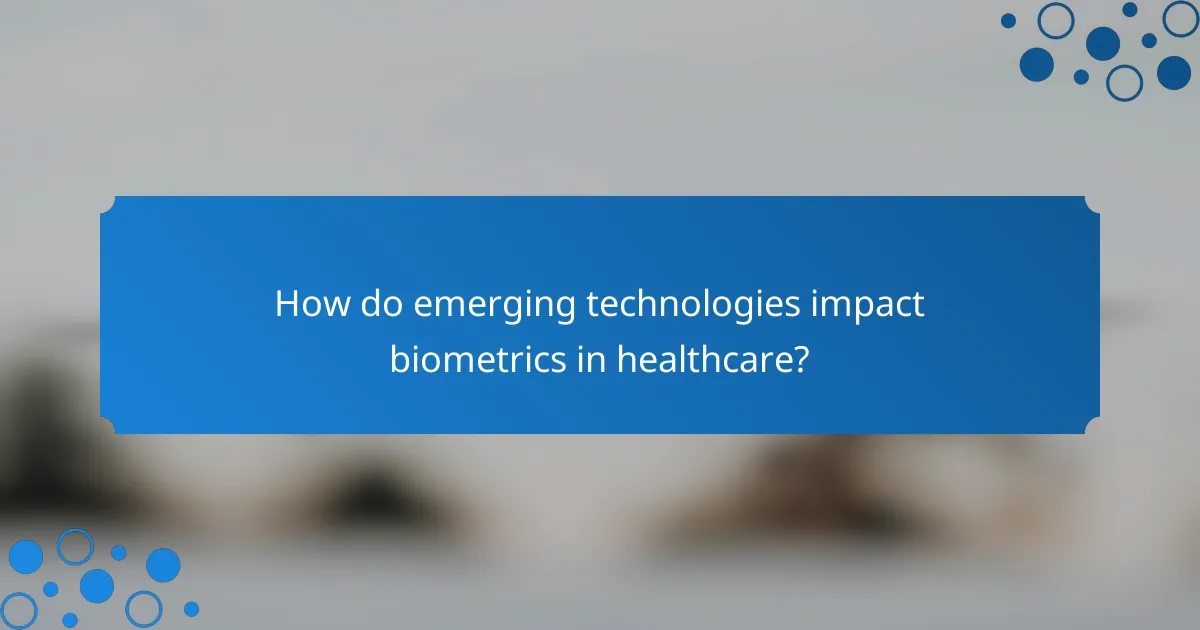
How do emerging technologies impact biometrics in healthcare?
Emerging technologies significantly enhance the application of biometrics in healthcare by improving accuracy, efficiency, and patient experience. These advancements facilitate better patient identification, streamline processes, and ensure secure access to sensitive health information.
Artificial intelligence in biometric analysis
Artificial intelligence (AI) plays a crucial role in biometric analysis by processing vast amounts of data to identify patterns and improve recognition accuracy. Machine learning algorithms can analyze biometric data such as fingerprints, facial recognition, and voice patterns, leading to more reliable patient identification.
Healthcare providers can leverage AI to automate and enhance biometric verification processes, reducing the likelihood of errors. However, it is essential to ensure that AI systems comply with privacy regulations and maintain patient consent throughout the analysis.
Trends in wearable biometric devices
Wearable biometric devices are increasingly popular in healthcare, providing continuous monitoring of vital signs and health metrics. Devices such as smartwatches and fitness trackers can collect data on heart rate, oxygen levels, and activity levels, allowing for real-time health assessments.
These devices often integrate with healthcare systems to provide physicians with timely information, which can lead to proactive patient care. As technology advances, the accuracy and functionality of these wearables are expected to improve, making them essential tools for both patients and healthcare providers.
Future of biometric authentication in telehealth
The future of biometric authentication in telehealth looks promising, as it offers secure and convenient access to healthcare services. Biometric methods such as facial recognition and fingerprint scanning can streamline the login process for telehealth platforms, enhancing user experience while maintaining security.
As telehealth continues to grow, integrating biometric authentication can help mitigate risks associated with unauthorized access and identity theft. However, healthcare providers must prioritize patient consent and data protection to build trust and ensure compliance with regulations like HIPAA in the United States.
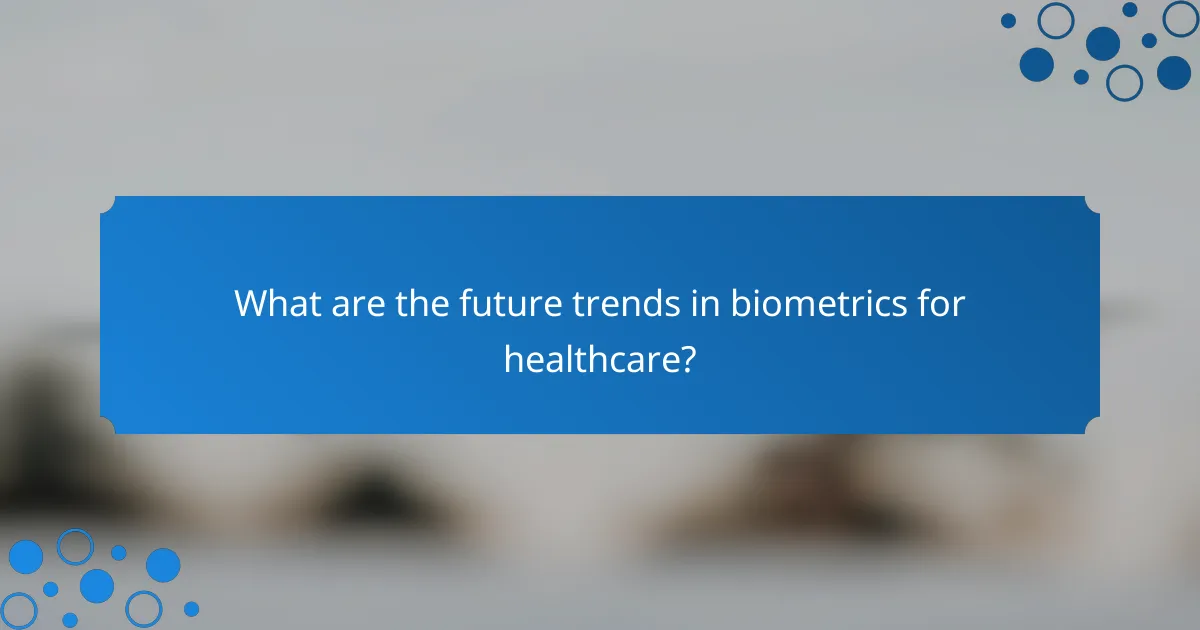
What are the future trends in biometrics for healthcare?
Future trends in biometrics for healthcare include enhanced accuracy, integration with emerging technologies like blockchain, and the potential for personalized medicine. These advancements aim to improve patient identification, data security, and tailored treatment plans.
Advancements in biometric accuracy
Advancements in biometric accuracy focus on improving the reliability of identification methods such as fingerprint, facial recognition, and iris scanning. These technologies are evolving to reduce false positives and negatives, ensuring that patient data is accurately matched to the right individual.
For instance, modern fingerprint scanners can achieve accuracy rates exceeding 99%, while facial recognition systems are becoming adept at recognizing individuals even in varying lighting conditions. Continuous research and development are crucial for maintaining these high standards in clinical settings.
Integration of biometrics with blockchain technology
Integrating biometrics with blockchain technology enhances data security and patient privacy. Blockchain can securely store biometric data, ensuring that it is tamper-proof and accessible only to authorized personnel, which is vital in healthcare environments.
This combination allows for a decentralized approach to patient records, where biometric identifiers can be linked to a patient’s health history without compromising sensitive information. As regulations around data protection tighten, this integration may become a standard practice in healthcare systems.
Potential for personalized medicine through biometrics
Biometrics has the potential to revolutionize personalized medicine by enabling more accurate patient profiling. By analyzing biometric data alongside genetic information, healthcare providers can tailor treatments to individual needs, improving outcomes and reducing adverse effects.
For example, a patient’s unique biometric markers could inform medication dosages or the selection of therapies, leading to more effective and efficient care. As the technology matures, the integration of biometrics in personalized medicine could significantly enhance patient experiences and treatment efficacy.
